The idea is to develop my observational and technical skills by focussing on this traditional genre of painting. We have some background on the Dutch Golden Age of painting in our study notes and I did do reading whilst doing the Drawing 1 course earlier this year. I realize this should add as the framework for this project. The outcome will be the opportunity, whilst painting, to explore technical as well as artistic possibilities of applying paint. I would like go back to my tonal study of the aloe plant in a glass pot. My husband is on a working trip and out of the country for at least a week and I decide to set up my still life in our bedroom – here the light is also great.
Research point 2 Dutch Still live and flower painters
I have to make notes on paintings that I especially admire, find out about the techniques that we employed, also research at least one painting with iconographic significance and then explore the development of still life through the eighteen, ninteenth and twentieth centuries.
I found the following definition of Still life on the Modern Met website: ” A still life (also known by its French title, nature morte) painting is a piece that features an arrangement of inanimate objects as its subject. Usually, these items are set on a table and often include organic objects like fruit and flowers and household items like glassware and textiles. The term “still life” is derived from the Dutch word stilleven, which gained prominence during the 16th century. While it was during this time that the still life gained recognition as a genre, its roots date back to ancient times.
The country was prospurous and they were world leaders as traders, with a growing middle class income group. It was also a repulic and governed by the middle class citizens. Genres which spoke to this new group of art collecters were, activities of everyday life; still life, landscapes, portraits, historical paintings. I found documents from which I could research online, through Academia.edu. Here I read that Jan Brueghel the Elder(1568 – 1625) and Ambrosius Bosschaert the Elder (1573–1621) are widely acknowledged to be the pioneers. I also read that all still lifes were ranked last in importance after history painting, portrait art, genre-works, and landscapes.
When it comes to flower paintings and the Flemish economical and cultural situation at that time, Christian symbolism should be kept in mind:
- classic vanitas elements such as droplets of water, shells, insects or decay
- landscape backgrounds that signal the majesty of creation
- the lizard is a symbol of the snake in the Garden of Eden, the butterfly symbolises the soul
- flowers such as a rose (The Passion) and and iris (the Virgin)
PAINTINGS I ADMIRE
Here I will show images and also research the techniques that were employed.
Ambrosius Bosschaert the Elder was a native of Antwerp. The painting below, A basket of flowers can be seen as having Iconographic significance. The following objects tell us a story: – a pink carnation, a white rose, and a yellow tulip with red stripes lie in front of a basket with flowers, that would not bloom together. The roses, forget-me-nots, lilies-of-the-valley, a cyclamen, a violet, a hyacinth, and tulips are short lived flowers, a reminder of the brevity of life and the transience of its beauty. It looks like a study of freshly picked flowers from the garden – a catterpillar is walking on the pink rose, which is lying face down in the basket. There are more natural elements, such as the caterpillar, butterflies to show the glory and beauty of nature.
I found that here was an artist who had a family of flower painters around him. On a YouTube video of Yale University I heard that most of the painters ‘invented’ these boquettes, and used botanical drawings/water colour paintings as references. This is an oil painting on copper. In his time there was a lively interest in natural history, which clearly motivated his works. “Clearly, then, the genesis of the painted flower piecearound 1600 cannot be seen in isolation from the con-temporary interest in botany in the humanist and courtlycircles of western Europe, where a cultivated taste foremulation stimulated talented artists to depict as sub-tly as possible the exquisite kinds of flowers that werecollected so eagerly.” (de Clippel et al: 78) They also eluded to the fact that Brueghel and Bosschaert were very much artisticly influenced by each other and ‘created this ‘mannerist flower pot still lifes, for which they became more know later years. Here they refer that these paintings …”are flower portraits in the form of a rather artificially and symmetrically composed bouquet painted with seem-ingly scientific accuracy, combined with some exoticshells and little insects or petals that have dropped ontothe ledge.” (de Clippel et al:79) I must say that looking at these works and thinking about a realist flower arrangement, the flower arrangements are done with one viewpoint – frontal, one does not get the idea of a ’rounded’ arrangement. – almost flat at the back? I do like this part of the article: “The story of Brueghel,Bosschaert and Middelburg also tells us that artists fromthe north and south continued to travel, even at a timeof all-out war, and that they looked at each other’s workand working methods in order to learn from and vie witheach other” (de Clippel et al: 86)

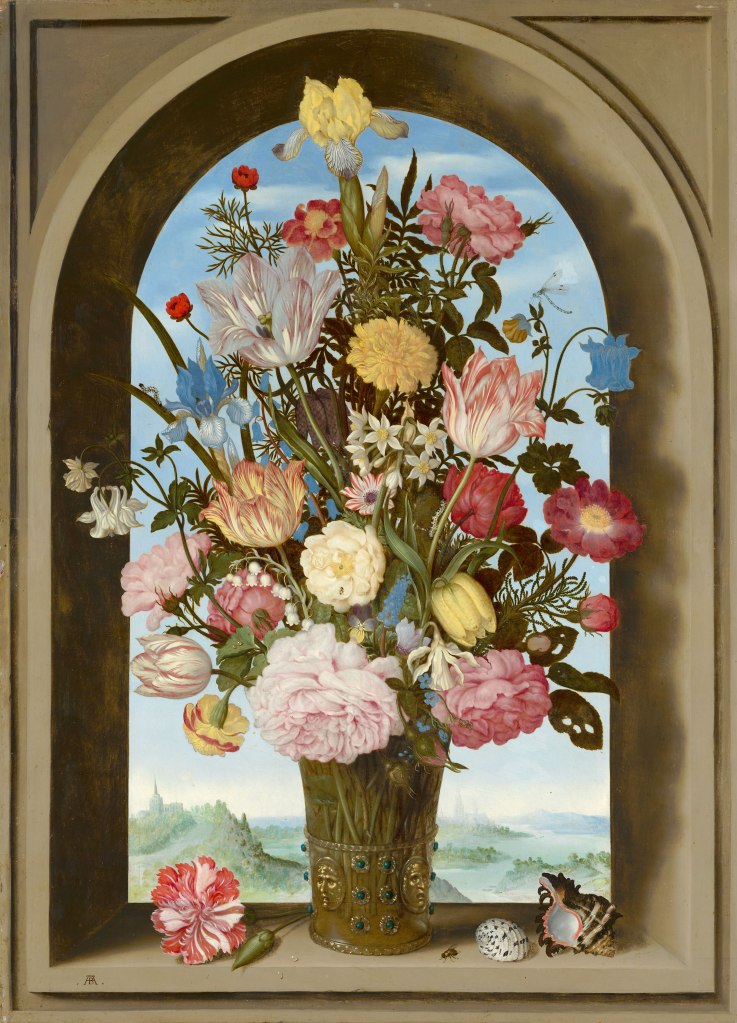
In the painting above the landscape in the back is interesting – this is a signal of the majesty of creation.
Jan Brueghel: Flowers in a Wan-Li Vase

Gerrit van Vught: Vanitas Still Life
This work below is done in oil on panel and part of the Rijksmuseum collection of still life paintings. One sees books, a skul and an hour glass on a table, all indicating that life ( time, knowledge, human life) is short and leads to inevitable death.

Adriaen Coorte, Still life with asparagus, 1697. According to the Rijksmuseum website, he produced mostly small, intimate still lifes, which I do find particularly lovely! I think he captured the essence of these objects and created a lovely atmosphere. .”Through their simple subjects – asparagus or berries – these modest paintings stand out in stark contrast to the sumptuous still lifes that were in fashion at the time. While the aim of those works was to present a superabundance of costly objects and foodstuffs, here attention is focused on the refined rendering of a single vegetable.” (quoted from the website of Rijksmuseum) It is clear that these asparagus imply the transcience of wordly things.
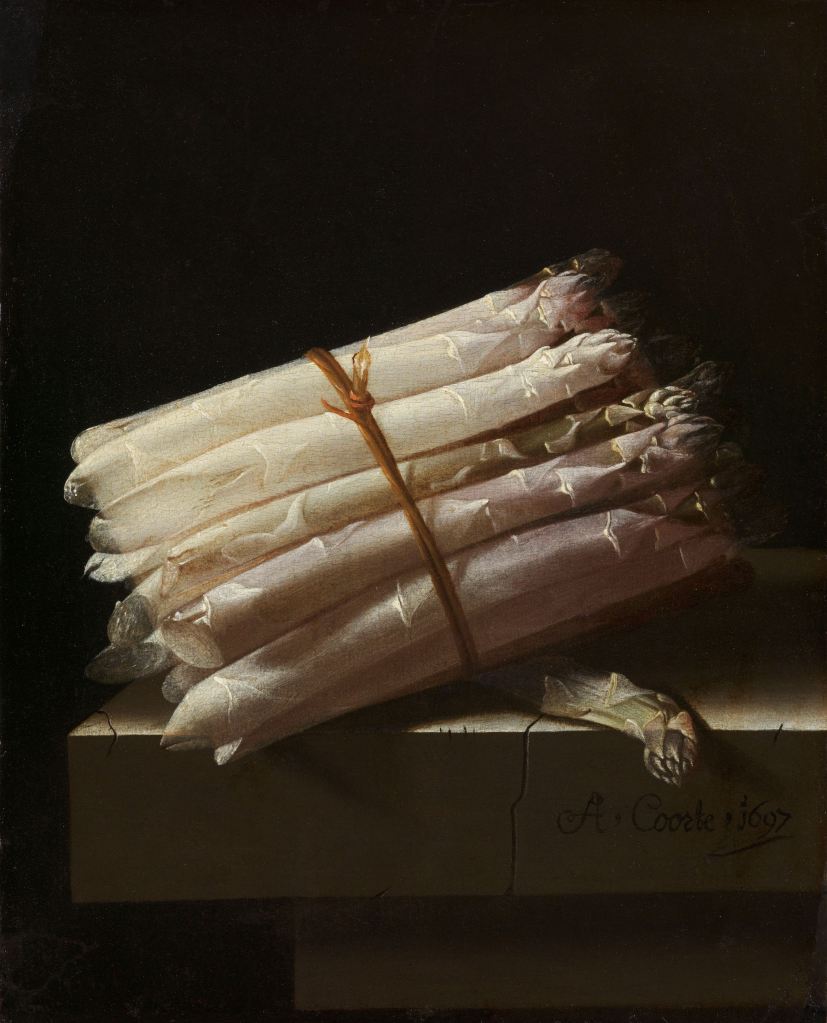
The painting is depicted against a dark background and the objects are layed on a plain stone plynth. He worked with thin layers of work, put layer upon layer as he worked. Hereby he could render details, like the shadows. Colours range from a delicate violet/pink to very soft greens.

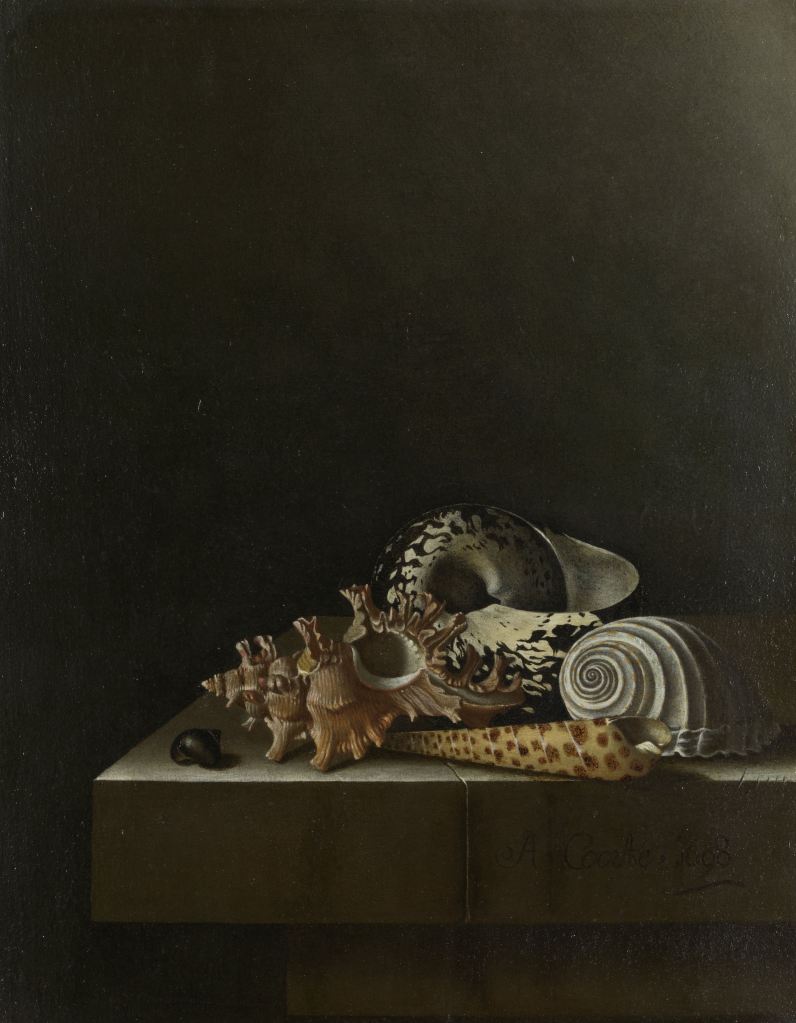
Above Coorte arranged shells on a stone plinth against a dark background in such a way that each one receives attention, displaying its own form, colour, and structure. Coorte, moreover, painted them life size, according to Rijksmuseum website. These kinds of exotic shells were brought to the Netherlands in the ships of the Dutch East and West India Companies and were highly prized by collectors, who paid enormous amounts for them.
Jan Davidz De Heem: A glass vase with flowers 1655 -60.

Here we have a very dark background. This work shows a seemingly hap hazard flower arrangement, but it is clear the artist used an organised composition. The centre/focus point is the Yellow and White flowers, then their is a central axis which runs up to the big flame likened Red tulip. He finds balance in arranging the flowers on the sides. The interesting part is the detail when one zooms in – again butterlfies, ants, herbs like rosemary, borage, marygold, peapods, a wheat stalk lying in front, hanging over the table ( reminds me of the lemons one finds on many still lives) In the glass vase on sees the image of the window from which the lights reflects onto the painting.
Clara Peeters: Still life with cheeses
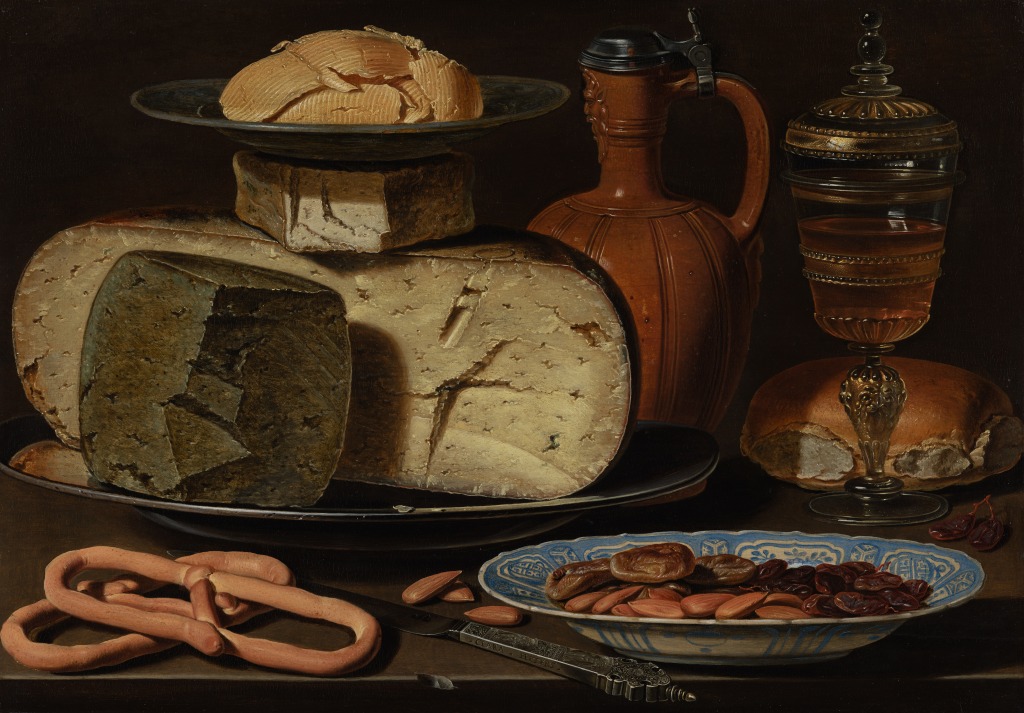
In this still-life, a table is laid with cheeses, pretzels and figs, alongside costly objects like a gilded Venetian glass and a Chinese dish. The Antwerp painter Clara Peeters was one of the first food still-life painters, and her ‘banketjes’ or banquet pieces had a great influence on the painters of the Northern Netherlands.
Besides putting her signature on the silver bridal knife, Peeters also painted herself. In the pewter lid of the earthenware jug, detail of picture below, one can see the reflection of a woman’s face with a white cap. The Mauritshuis Museum states that this is Clara’s self-portrait.

Willem Glaesz .Heda, 1634 Still life with gilded beer tankard

According to the Rijksmuseum not much is known about Willem Heda (1594-1680). He lived in Haarlem, joined the St Luke’s guild there in 1631. He painted several figure studies in his early career, but later concentrated exclusively on still lifes. Rijksmuseum says that “Heda was the consummate master in depicting light reflected on smooth, shiny surfaces such as pewter, silver or brass candlesticks. He often depicted the same objects in different paintings, which became known as ‘banquets’ or ‘breakfasts’.” (museum information on the artist) Interesting that a breakfast is so much more as what we would see it for today. I must say, a brunch, such as the ones the expat community does here in Dubai, could very much be in such an indulgent way as these works about ‘banquets’ display.
References
De Clippel, K & Van der Linder David, The genesis of the Netherlandish flower piece:Jan Brueghel, Ambrosius Bosschaert and Middelburg, Academia.edu, Pdf downloaded on 13 October 2019
Weis, Amanda 2017 Seventeenth-Century Dutch Still Life and the Bosschaert Painters: Is There a Real Art of Tulip Mania? Dowloaded as a PDF document from Academia.com on 14 October 2019.
Maurtishuis Website, photos of works could be downloaded there, with detail areas shown.
The development of still life through the eigthteenth, nineteenth and twentieth centuries
Reading on the Met website the following ideas on Still Life is apt for this research :”In general, the rise of still-life painting in the Northern and Spanish Netherlands (mainly in the cities of Antwerp, Middelburg, Haarlem, Leiden, and Utrecht) reflects the increasing urbanization of Dutch and Flemish society, which brought with it an emphasis on the home and personal possessions, commerce, trade, learning—all the aspects and diversions of everyday life. Floral still lifes were especially prominent in the early 1600s, and in their highly refined execution and in their subjects and symbolism were addressed to a cultivated audience. Painters such as Ambrosius Bosschaert the Elder, Balthasar van der Ast, Roelandt Savery, and Jacob Vosmaer often referred to herbals and other botanical texts when composing “bouquets” (like Vosmaer’s A Vase of Flowers; 71.5), which typically combined flowers from different countries and even different continents in one vase and at one moment of blooming.” https://www.metmuseum.org/toah/hd/nstl/hd_nstl.htm
It seems there were significant schools of still-life art in Italy (especially Naples) and Spain, and to a lesser extent France; and perhaps due to the conservative influence of the Parisian Academie des Beaux-Arts, still-life painting took longer to develop in France than in its northern neighbours. In France Chardin was one of the greatest still-life painters of the 18th century and Paul Cezanne of the 19th century.
Jean Baptiste Simeon Chardin (1699 -1770 was best known for his still life paintings. He was interested in the seventeenth century Dutch still lifes and chiaroscuro Itailian Baroque works. He primed his canvas with a red-orange colour which he covered with a light gray-brown ground (reminds me of Rembrandt? ) – by doing, according to Arisitedes, (2008:166) this, ” he had an optical gray upon which he painted.” She shares his palette: lead white, Naples Yellow, vermilion, ocher, burnt umber, ultramarine blue, prussian blue. He layered his brush strokes and worked slowly. He clearly cared much about the feeling of his work.

Looking at Spain,I read about the following artists,Juan van der Hamen, Pedro de Camprobín or Juan de Arellan It seems that by the beginning of the 17th century, pictures of ordinary, even low-born individuals began to appear, reflecting a move towards an increased interest in realism, evidenced in paintings of every day life (e. g. Velázquez’s Old Woman Frying Eggs, 1618). I particularliny loved seeing a painting of Velzquez depicting view of the Villa Medici in Rome ( Prado Museum). This is a small impressionistic garden scenes of remarkable originality. And then read that Velázquez was much admired by the Impressionists. A recent newspaper article on a Rijksmuseum show where they juxtaposes Rembrandt and Velazques came to mind and I will use some of the information I found there for this part of my research. (FT Weekend 12 October 2019:12)
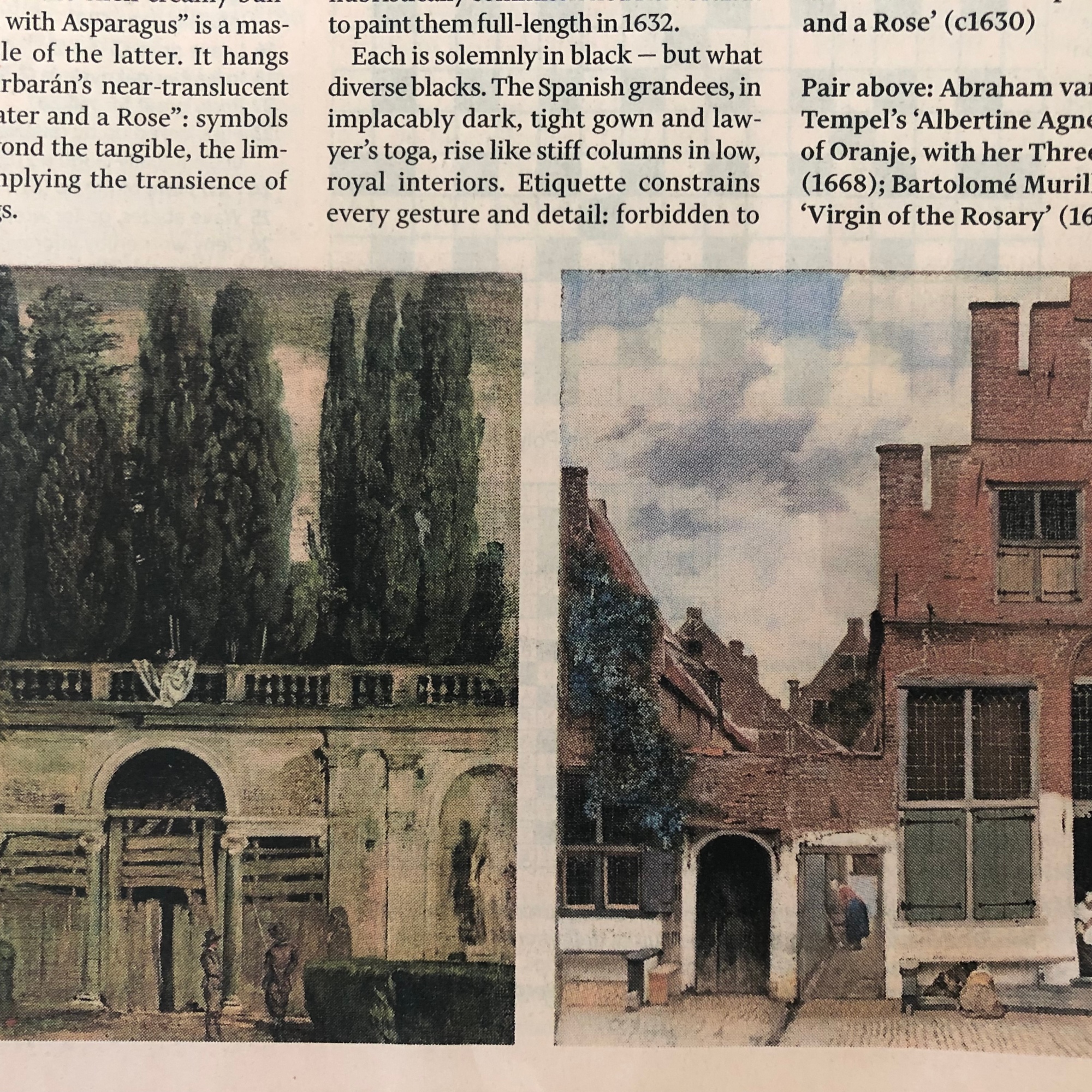

Velazuez’s work was done in 1630 or 1649 and Vermeer’s work c1658. They were direct contemporaries, who never met or encountered each other’s work – there countries were mostly at war in their lifetimes. Both these painters almost perfected a form of realism with great light effects.

It is clear that by the 18th century artists were traveling much more and artistic influences became stronger, as they could view works, not just prints. On the Guggenheim website I read the following:”Bodegón is the Spanish term for still life (from bodega, a storeroom or tavern). Taken more generally, bodegón refers to the representation of common objects of daily life, frequently including food. The still life image may contain piles of fruit, silvery fish lying on a plate, game birds hanging on a wall, or arrangements of flowers. Still lifes may also contain shiny pewter vessels, transparent glasses, woven rugs, books, jars, pipes, a writer’s inkwell, or the painter’s brush and palette. There are works that display the ingredients for an upcoming meal. All manner of inanimate objects are suitable subjects for still lifes, for the painter’s skill suddenly makes us aware of the artistic properties of ordinary things.”

Guggenheim tells the following about his work: “All still lifes by Sánchez Cotán display their objects within a window setting. This shallow, precisely defined space allowed the artist to achieve, through the strong modeling of forms in light, a truly compelling sense of space. He connected this space to the viewer by arranging certain objects so that they protrude over the front edge of the windowsill, also suspending others from invisible hooks above. The hanging vegetables may look strange, but in Spain at the time this was a normal way of protecting produce from pests. At the right, a bunch of parsnips and carrots hangs slightly in front of the window, while on the sill below, a pink and white cardoon lies on its side. The dark background against which the fruits and vegetables are silhouetted provides a sense of great depth. A powerful light greatly enhances the surfaces and textures, yet somehow fails to illuminate the background space, which remains submerged in deep shadow. The window becomes a sort of stage on which the high drama of art imitating nature is played out.”
According to Pound (bbc.com website) Goyas food still lifes from the early 19th Centrury reflected something very different as he was working on The Distaters of War series and strongly influenced by the Napoleonic invasion of Spain. It seems that other artists also started abandoing the humble motives and focussed on what the growing bourgeoisie suited. On the website of the Houston Museum of Fine Arts, I read the following: “Still Life with Golden Bream, he has captured the physical beauty of the fish while at the same time seeming to identify strongly with the animal’s demise. The fish appear to be piled on a grassy knoll near a beach, which Goya has deftly suggested by the foam of a wave breaking diagonally from lower right to upper left. The scene is illuminated by moonlight glinting across the wet, scaly bodies of the fish and reflected in their large, staring eyes. Goya departs from traditional artistic depictions of dead animals, investing his still lifes with great pathos. Parallels can be drawn between Goya’s representation of animals and his treatment of human corpses in his riveting series of prints Disasters of War, one of the greatest accusations against the horrors of war.”

It is quite a stare that one encounter of these dying fish – reminds me of the work a included of a contemporary artists of today, Cindy Wright. The context of the narritive in the works are just different and relate to what the artists were thinking .
By the Nineteenth century Henri Fantin-Latour became renowned for his still-lifes of flowers such as, White and Pink Roses (1890), as well as other compositions such as, Still Life with Vase of Hawthorn, Bowl of Cherries, Japanese Bowl, and Cup and Saucer (c.1880). Bonnard was part of a group called the Nabis, and was inspired by Art Nouveau and Japanese prints. I do like his paintings of interiors – very intimate.

The Impressionists were exploring the colourist effects of flower compositions, we see Paul Cezanne giving both his still-lifes and landscapes an unprecedented monumentality from which Cubism is largly derived. Cezanne’s masterpieces include: Pears on a Chair, Still Life with Basket, and Still Life with Plaster Cupid (1895). It is almost as if the subject matter could have narrowed in the way he was fascinated by light , but then one sees more artistic expression broadening with his use of form. It seems Cezanne “put this genre on another plain” (bbc.com refer to Aterido). He used abstract backgroundsh and with experiments with colour form and line he also inspired Picasso, who used this to create his Cubist paitings. It seems by now this genre of painting got the attention of critics and was taken up by artists such as Miro, Dali, Morandi and Richter – whom all brought constant development in approach.

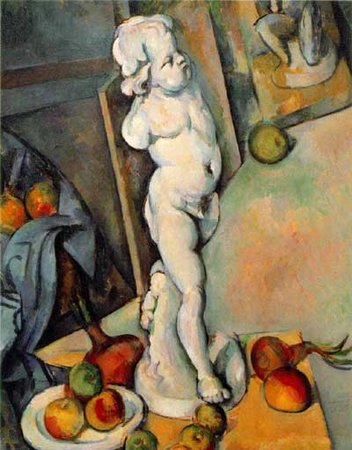
Looking at the upper half of the plaster figure, one can see that it is a different perspective than for example the apples in the table. It is almost as if Cezanne shows different views of the objects in his painting – making them individualy kwown within the whole of the painting by focussing on form. The Dutch Post-Impressionist artist Vincent Van Gogh again use rich yellows in his famous Sunflower paintings.
In the United States American artists painted still life throughout the nineteenth century. Leaders in the genre included the Philadelphian Raphaelle Peale (1774-1825).
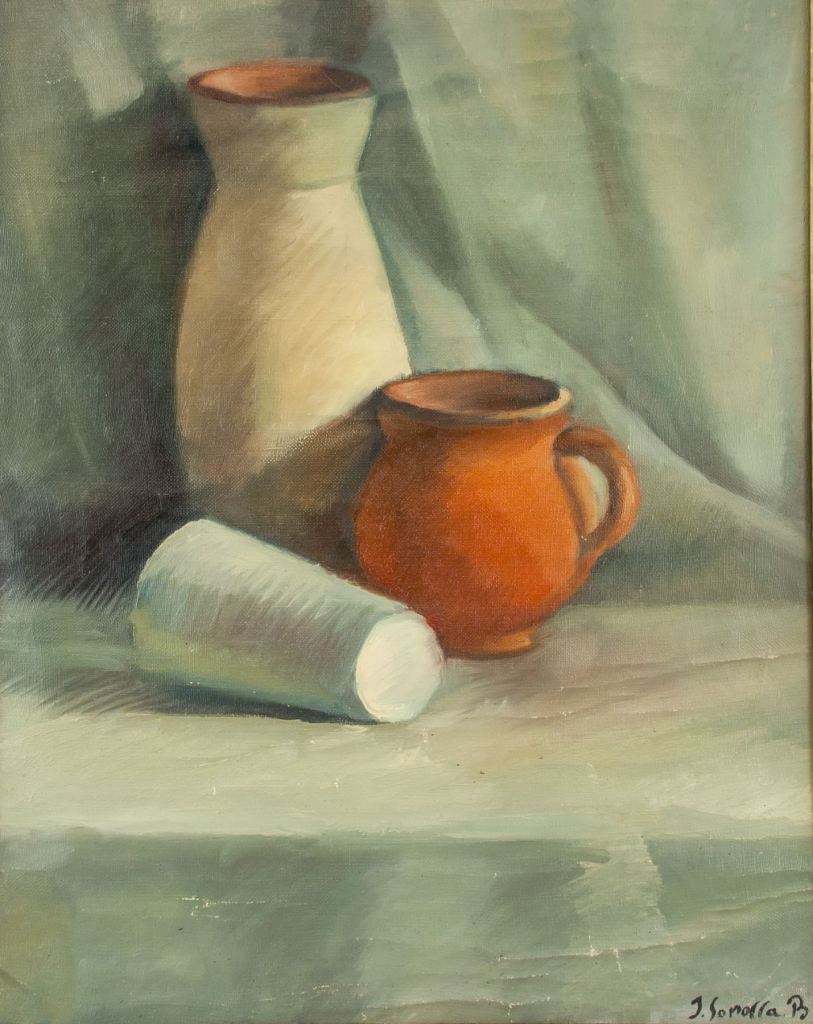
Joaquin Sorolla was interested in open-air painting, with which he tried to capture Mediterranean lighting, both in the farmlands of Valencia and on the beach, just as the French Impressionists did. To me he was an artist who painted what he saw – he was captured by white light – brightness. I also looked at the work of Bonnard and Vullard at this time, as they added elements which was inspired by Japanese woodcuts.
I cannot leave out the works by Henri Matissem who used bold and flat outline which was filled with colour.


Gold fish appear an a few of Matisse’s paintings, as well as in his drawings and prints. The central focus of above painting is the fish and their colour attracts one when looking at the compisition. Here Matisse is placing complentary colours next to each other and it makes them appear brighter. Its seems this was a Fauvest technique. It seems his intent was to give the viewers something that could make them feel relaxed – idea of a tranquil state of mind, as well as contemplating about a paradise lost? (henrimatisse.org website was used for the information)

Georges Braque’s Cubist still lifes shows how he developed his own individualist style. The invention of the papier collé in 1912 by Braque and Pablo Picasso introduced a revolution in Western painting – pasting fragments of paper (newspaper, wallpaper, and wood-grained paper) onto their still-life compositions, they introduced real materials and textures (even used sand) .
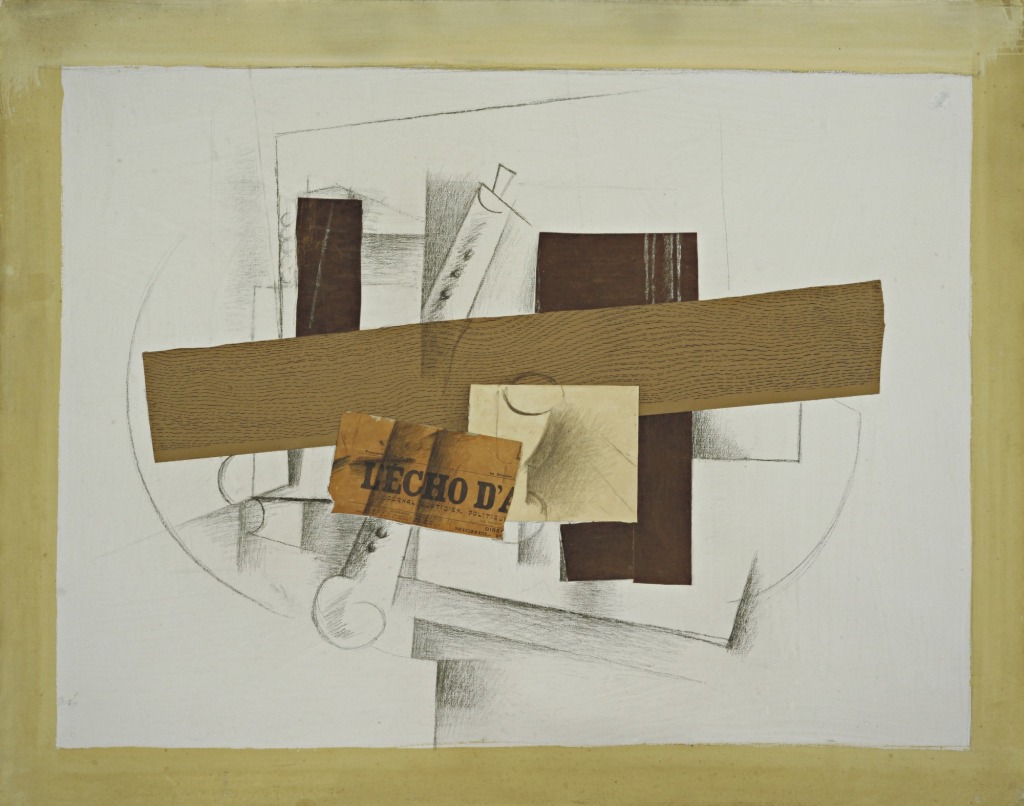
Below is a work by Walter Tandy Murch, which I found in a book of Aristides (2008:172-173) This artists lived and worked in New York, 1907 to 1967. He was ‘discovered’ by Aeshile Gorky. He oftern chose lowly or forgotten objects, which he would combine with more conventional still life objects, sugh ar oranges, eggs or apples.


Above work was really an interesting find on the Tate website! This artist used a palette knife, and with rags he wiped away paint. He used vigorous brush strokes to create an active surface.
The electric chair first appeared as a subject in Warhol’s painting in 1963, the image taken from a black-and-white wire photograph of the notorious Sing Sing Correctional Facility in Ossining, New York.
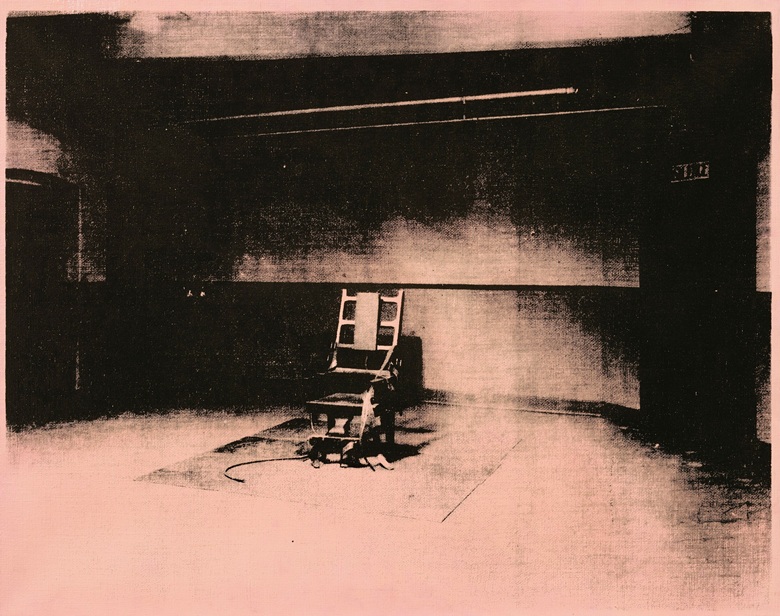
In Little Electric Chair, the Warhol intensifies the contrast of the image to spectacular effect. He highlights the empty chair while allowing dark shadows to pool in the corners of the empty room – hereby creating great atmoshere. Little Electric Chair is part of his Death and Disaster series, with which Warhol wanted us to think about death and how it is portrayed to us via contemporary media outlets.
I came upon the works of current century artists in my studies for Drawing. Recent works have a contemporary twist on the timeless tradition by painting still lifes of modern-day food and objects in a hyperrealistic style, and like the pieces by which they are inspired , these paintings prove that even the most mundane objects can be made into masterpieces. Below is a work by Cindy Wright – it speeks very accusive and confrontational to the audience through the eye of the fish which is staring from the glass fish bowl – interesting is the white doily on which it is placed. Here we have a clear reminder, that eating meat and fish comes at a real cost, the death of once living creatures.

Looking at the work of Rebecca Scot was also a personal confrontation. Her series of 2006, The Perfect Life is a questioning the marketing in women’s magazines and catalogues about the job of a woman to make her home perfect. She paints these readymade images that hope to instruct her and other women to buy such wares and in doing so disrupts what would otherwise be traditional still life.


References
Pound, Cath, 2018 , Secret symbols in still life painting, bbc.com Culture website, accessed on 16 October 2019
Van der Linden, David, Coping with crises: Career strategies of Antwerp painters after
1585, Academia.com, pdf downloaded
Reflecting on this learning
I have looked at using still life as an academic exercise in composition, texture, colour as well as learning about the technical skill of the artists. It became clear how, in the Golden Age of painting, the socio/economic events of the day played such a big role on the development of this genre, and this witin the developing knowledge and understanding of colour and paint application.
Even though the flower still life works I have viewed are exquisite and detailed in their rendering, as well as the beauty of the objects it reflected, I do not feel comfortable to attempt this. I do think I am more attracted to the fruit/vegetables ( my liking for eating?) or the books/skull/ natural found objects, I like, idea of exploring Still Life. this scene.
Thinking about colour I read the following which I do think is of importance to take with me. I read that Monet painted The Gare Saint-Lazare, (also known as Interior View of the Gare Saint-Lazare, the Auteuil Line), which depicts one of the passenger platforms of the Gare Saint-Lazare, one of Paris’s largest and busiest train terminals, without using any earth pigments.

He creaed his rich browns and grays by using cobalt blue, cerulean blue, utramarine, emerald green , viridian, chrome yellow, vermillion and crimson lake, with small touches of lead white and ivory balck. For Monet it was about those moments of observing colours. Monet’s painting, The Gare Saint-Lazare, overwhelms the viewer not though its scale (a modest 29 ½ by 41 inches), but through the deep sea of steam and smoke that envelops the canvas.